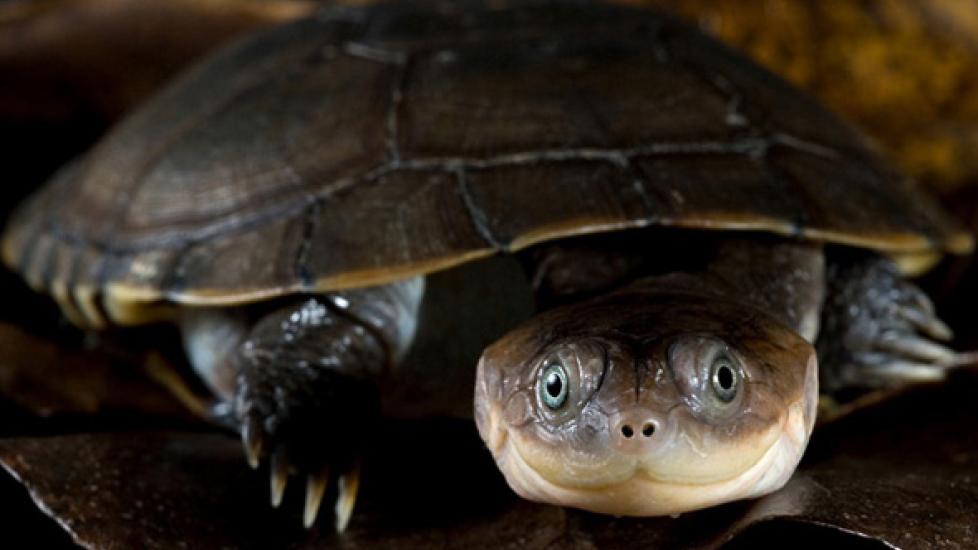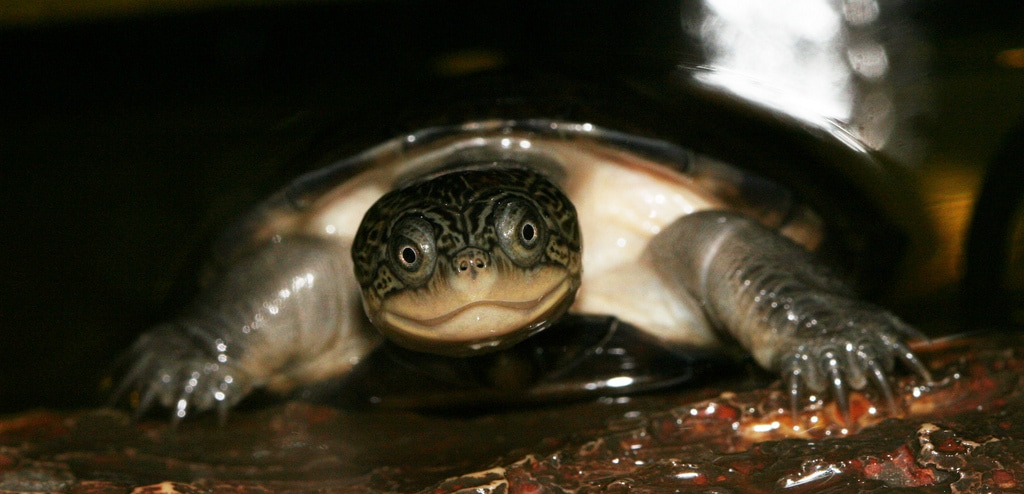African Sideneck Turtle - Pelusios castaneus
Varieties
There are currently no recognized subspecies of African sideneck turtle. They are very similar to the African helmeted turtle, however, and the names are frequently interchanged. Another common name they are known by is West African mud turtle
African sidenecks get their nickname due to their inability to withdraw their heads fully into their shells, instead drawing their head to the side and under the upper edge of their shell.
African Sideneck Turtle Size
African sidenecks are on the larger-side of the spectrum and can reach an adult size between 7 and 12 inches, with the females reaching a larger size than their male counterparts. Male sidenecks grow to reach a maximum length of about 10 inches.
African Sideneck Turtle Lifespan
When given proper care, African sideneck turtles can easily live for a few decades. Some reports suggest species living for more than 50 years in captivity.
African Sideneck Turtle Appearance
African sidenecks are typically dark colored, and their underbellies (called plastrons) are a grayish black color with a wide, poorly defined yellow area. They have olive-to-brown heads with black markings on top, and two barbels (beard-like sensory organs) that protrude from the lower jaw. They have lightly webbed feet with long, sharp claws, or nails. In the image below, you can see the two barbel nubs on the chin of this young African sideneck turtle.
Image by Laurent Lebois, on Flickr Creative Commons (click image to se larger view)
Unlike many turtle species that have more serious reptilian features, the African sideneck has a face that can be described as cute, with a mouth that is fixed into a smiling shape and big round eyes. When it pulls its head to the side to tuck under its shell, it appears to be playing coy.
While there aren’t any official subspecies, there are three variations that the African sideneck can take on. The “normal form,” which is as described above; the “rainforest form,” where the turtle displays an all over dark brown or black shell; and the “savannah form,” which takes on a lighter, buttery color of caramel, with a full yellow plastron.
African Sideneck Turtle Care Level
Due to its environmental requirements, moderate size, and long lifespan West African mud turtles/sideneck turtles are best left to intermediate and advanced turtle keepers. That said, they are hardy turtles and can withstand periods of deprivation.
African Sideneck Turtle Diet
What and When to Feed Your African Sideneck
In the wild, African sidenecks are omnivores, munching without discretion on insects, plants, and fish that are native to its habitat. When it comes to feeding your African sideneck, variety is the key to success. No matter how much your turtle prefers a single food type, always feed it a variety to prevent it from developing a fixation. Aside from variety, don’t overfeed your turtles! Adult sidenecks should be fed as much as they will eat in a few seconds, once every second or third day.
When they’re young and growing, Insects and protein should make up the majority of your sideneck turtle’s diet. As they get older they tend to give up most of their carnivorous tendencies.
For meat proteins you can feed your sideneck earthworms, snails, clams, fish, aquatic insects, cooked chicken pieces, beef hearts, crustaceans, and maybe some small amphibians. As for the greenery, stick to nutrient-rich greens like spinach, romaine, and red-leaf lettuce (never iceberg). You can also feed your turtle chopped collard greens, dandelions, and mixed vegetables, too.
Since sidenecks are aquatic turtles, they eat in their tanks and meals can become messy. To avoid frequent tank cleanings, simply remove your turtle from its tank and feed it in a separate container. If you keep multiple turtles, we recommend feeding them one at a time, as described above, to avoid food aggression and feeding frenzies.
Supplements
To ensure your turtle is receiving the right amounts of nutrients, we also recommend providing a calcium block or other vitamin and mineral supplements periodically.
African Sideneck Turtle Health
Like other cold-blooded creatures it’s important to provide the proper lighting, heating, and dietary requirements. Otherwise, African sideneck turtles are extremely hardy creatures. That being said, it’s a wise idea to have a reptile veterinarian on hand before you even bring your pet turtle home. If you suspect your West African mud turtle to be suffering from any ailments, contact your reptile vet as soon as you can.
Some of the common illnesses that your turtle may experience throughout its life are:
- Dehydration
- Malnutrition
- Parasites (internal and external)
Dehydration
Weigh your turtle regularly to monitor its weight. If it experiences a significant and unexplainable change in weight, dehydration or illness could be the cause.
Vitamin D3 Deficiency/Calcium Deficiency
African sideneck turtles that are suffering from a lack of Vitamin D3 and/or calcium may display swollen eyes or limbs and open wounds on the skin.
Parasites
Lastly, if you notice little worms floating around in your turtle tank, if your turtle is unable to swim or breathe properly, or if your turtle has a lot of bubbling coming from its nose, it probably has a parasite problem.
African Sideneck Turtle Behavior
African sideneck turtles are hardy, active, moderately sized and naturally abundant. They are relatively undemanding and make for great pets but can be curious almost to the point of aggressive. They can also be aggressive with each other, but mainly this occurs when they are eating, mating, or kept in a habitat that is too small or dirty. They are not known for being aggressive with people, but if they are nervous they may use their claws to try to escape.
If you’re looking for a pet that will provide you with entertainment and make an interesting display, African sidenecks are a great choice.
Supplies for the African Sideneck Turtle’s Environment
Habitat or Aquarium Setup
Depending on your local climate, African sidenecks can be kept indoors or outside. African sideneck turtles do not hibernate seasonally, as some other species do, so they should only be kept outside when the outside temperatures are warm.
For the sake of this piece we’ll mainly cover inside housing requirements. There are only a few things that West African mud turtles/sidenecks require to live happily:
- A tank
- A dry spot
- Lighting
- Heating
- Food
You can use a variety of things as your turtle tank, including all-glass aquariums, large Rubbermaid totes, baby pools, custom-built enclosures, etc.
For a group of adult West African mud turtles, an area of 6 feet by 3 feet that can hold between 125 and 175 gallons of water will suffice. For single turtles, a 40-gallon glass aquarium will suffice as well.
When choosing a turtle tank, wider is always better than taller. Remember, turtles don’t jump, they like to float, dive, and bask. Your water level should be at least 1.5 times the length of your turtle; the ideal depth is from 6 to 8 inches.
The one essential piece of decoration you need to have is a place where your turtle can haul out of the water to dry off, preferably under a basking light.
For substrate, you can either use large pebbles/gravel (too big to swallow), or you can use nothing at all. Keep in mind that any type of substrate will collect food and digestive waste, making cleanups a bit more time intensive.
To keep your turtle tank clean you can either change the water frequently, every few days or so. To keep the water relatively clean between cleanings, you can buy a tank filter from your local pet store; just be sure that it is powerful enough and has a flow rate of 350 gallons per hour.
Branches and Shelters
It’s a wise idea to outfit your turtle tank with things that appear in the turtle’s native habitat. In the case of the African sideneck this includes driftwood, large flat rocks (some of which should be used to create an above water basking spot under the UVB basking light), cork bark slabs, and plants.
While sidenecks don’t “climb” trees, they do have powerful claws on their feet that enable them to climb inclines. Turtle- and water-safe logs and other types of wood in the aquarium are good for your turtle, but arrange them in a way that will not allow your turtle to use them to launch itself out of the tank, otherwise you may have an injured turtle on your hands.
A mix of artificial and live plants is fine, just make sure that there are plenty, as the sideneck needs to be able to hide away when necessary, especially in a multi-turtle habitat, where it will need to hide occasionally from other turtles that are getting aggressive.
Heat and Light
Lighting can be provided via fluorescent and incandescent light bulbs from above or via an undertank heater. Always pair your lights with digital thermometers to ensure proper temperatures are maintained. A good temperature range for your turtle’s water is between 70 and 75 degrees Fahrenheit. The basking area should be kept at a temperature between 95 and 100 degrees Fahrenheit, with the ambient room temperature remaining in the low 80s.
Lights are not just for warmth. Aquatic turtles like the African sideneck benefit from ultraviolet lights, too, particularly from UVB rays. These rays give turtles Vitamin D3 and can help them stay healthy. When placing UVB/UVA lights, keep in mind that any plastic, plexi-glass, or glass blocking them will prevent the beneficial rays from reaching your turtle. Also, UVB lights lose their UVB strength over time, even though the bulb continues to emit light. It’s a good idea to mark your calendar to change the UVB bulbs every 9 months.
When provided with the proper environment and diet, your African sideneck turtle will give you years of companionship.
African Sidenecked Turtle Habitat and History
The African sideneck is native to the West African countries of Angola, Guinea, Ghana, Senegal, Liberia, Sierra Leone, and the Congo. They live in rivers, lakes,and ponds during the wet season and bury themselves deep in the mud (called estivating) during the dry seasons. They have also been known to estivate in underground burrows when temperatures get too warm, reemerging when temperatures become suitable again.
This article was verified and edited for accuracy by Dr. Adam Denish, VMD.

